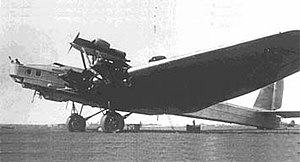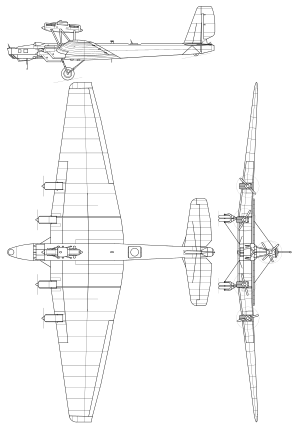Tupolev ANT-16
| ANT-16 (TB-4) | |
|---|---|

| |
| Role | Heavy bomber |
| National origin | Soviet Union |
| Manufacturer | Tupolev |
| First flight | 3 July 1933 |
| Status | Retired |
| Primary user | Soviet Union |
| Number built | One |
| Developed from | Tupolev TB-3 |
| Variants | ANT-20 |
Tupolev ANT-16 (also known as TB-4; Template:Lang-ru – Heavy Bomber) was an experimental heavy bomber aircraft designed and tested in the Soviet Union in the early 1930s. Conceptually representing evolution of the TB-3 bomber, ANT-16 was designed under the doctrine that size and payload were more important for a bomber than speed because it would be able to protect itself with defensive armament.[1] The twin 5×1.8×1.8 m (16 ft 5 in × 5 ft 11 in × 5 ft 11 in) bomb bays were the largest in the world at the time and presented many design challenges in order to preserve structural rigidity of the airframe.[1]
The sole prototype first flew on 3 July 1933 with M. M. Gromov at the controls. The test flight program was completed by 29 September 1933 with disappointing results. The two top-mounted engines performed poorly and a significant portion of thrust generated by the wing-mounted powerplants was absorbed by the 2-meter-thick (6 ft 7 in) wing. A proposal to re-equip the aircraft with Mikulin AM-35 engines of 933 kW (1,250 hp) was not implemented.[1]
Specifications (ANT-16)

Data from Shavrov 1985[1]
General characteristics
- Crew: Twelve
Performance
- Time to altitude: 34 s to 2,000 m (6,560 ft)
Armament
- Guns: 2x20mm cannon, 5x2 7.62mm DA machine guns
- Bombs: Up to 10,000 kg (22,046 lb) of bombs – 40 × 250 kg (551 lb) or 20 × 500 kg (1,102 lb)
See also
Related development
